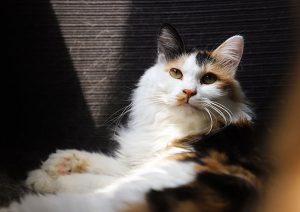Have you ever wondered what your cat is trying to say to you? Cats communicate with us in a variety of ways, many of which may go unnoticed. Body language, meowing, purring, and tail waving can mean lots of things, but they are all clear signs that our cats are telling us all about themselves.
You’ve probably heard someone say “Cats only give attention to people who don’t like them!” Often this is a clear sign that a cats natural methods of communication are not being recognized. In truth, cats prefer subtle signals to overly friendly overtures – a soft purr, a flick of the tail, a movement of the eyes is enough for them to communicate. This makes the extremely friendly neighbor who greets kitty by charging toward her and scooping her up might be a bit much for the average cat. She may see your friend who hates cats as much more polite, as a person who understands that cats like to choose how and when they greet visitors.
Our feline friends like to get to know people gradually, learning what type of noises get a response and using those to “adjust” their language in order to tell us what they like, what they need, and when we are making them unhappy. In general, cats don’t meow at each other after kittenhood – kittens meow largely because they are blind and need to “find” their mothers and let them know they need care. Cats treat us in the same fashion as their care givers, and will “talk” to us to let us know what they need. Over time, a cat learns what type of meow gets a reaction, and they will “learn” that meow as a word that means “please do this for me”.

Other types of “talk” include trilling – you may have heard your cat make this noise when you come home from work or when you are feeding her. This happy noise somewhere between a meow and a purr is a universally happy greeting. You may also have heard your cat make a “chirping” noise while watching birds or small animals through the window. The sound often means that your cat is very excited or frustrated by something. Some cats will even “mutter” like this when they lose a toy under the sofa.
Tails can be equally communicative. A good general rule is that the faster a tail is swishing, the more upset and agitated the cat. A slow wave back and forth could mean that your cat is mildly annoyed or simply interested in something that they see. Active thumping and twitching is usually your cat telling you to “leave me alone, I’m busy”.
If your cat greets you with a lovely trill and holds her tail vertically, perhaps even quivering a bit at the tip, she is telling you she likes you and is very happy to see you. Meanwhile if she is sleeping and you call her and the only response you get is a slow tail wave or a sleepy flick, she is letting you know that she heard you – she just isn’t going to get up right this minute (unless you are opening a can of cat food).

Cat enthusiasts will tell you that cats communicate with their eyes, and that if you “slow blink” when she is looking at you, she will take your blink as an invitation to spend time together and a sign of affection. Cats, much like humans and dogs, use facial expression to show affection, anger, excitement and fear. Closed or squinted eyes and slow blinking are a way that cats tell each other “I am relaxed” and can also be a way to cats to say “I would enjoy your company right now”. Try closing your eyes slowly when you make eye contact with your cat and notice how she reacts – you may be surprise to find her eagerly climbing into your lap.
Rubbing is another way for cats to say “I’m comfortable with you”. When kitty rubs her cheeks against you, she is expressing her desire to get to know you better, or using her scent to let everyone know that you belong to her. Head butting is even more personal, expressing happiness and affection.
Cats have a unique ability to adapt their behavior to better communicate with their owners, so your cat’s language may differ slightly from the methods of another cat. These general tips will help you to be more sensitive to her signals and may help you to adapt YOUR communication skills to understand her better. Before you know it, you could be having a conversation with your cat!

